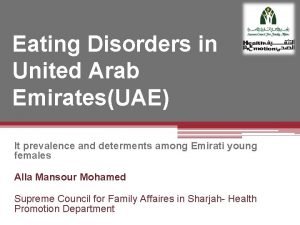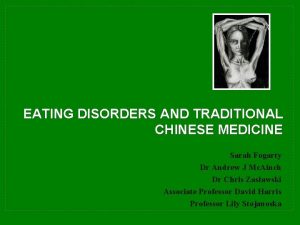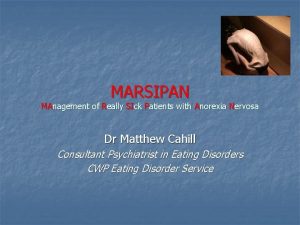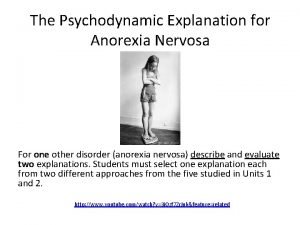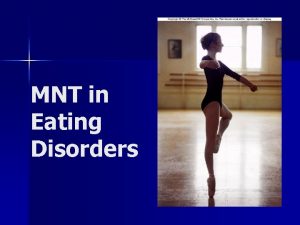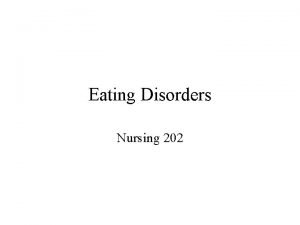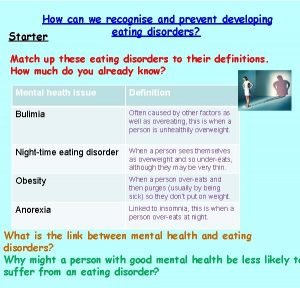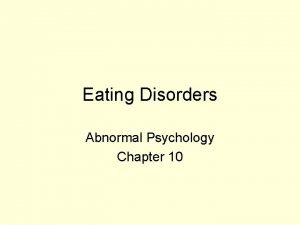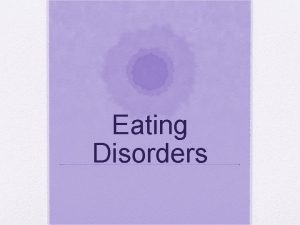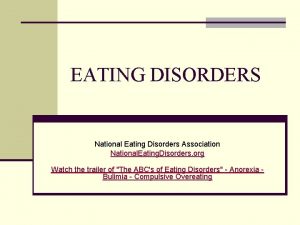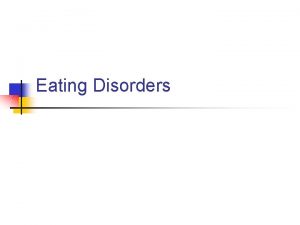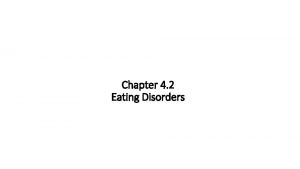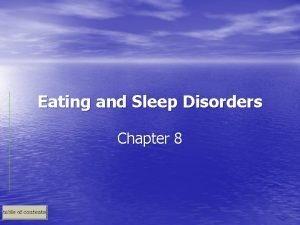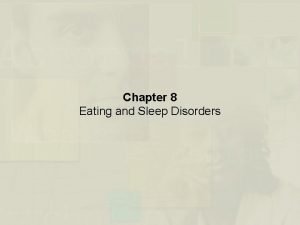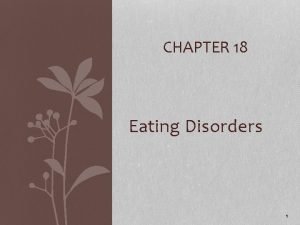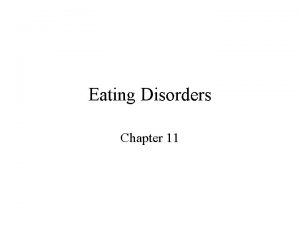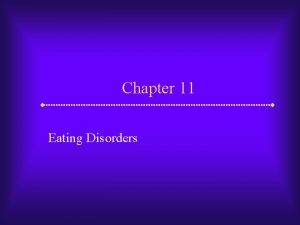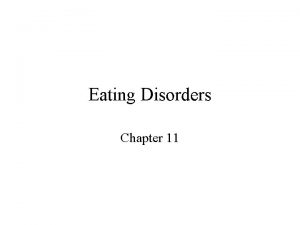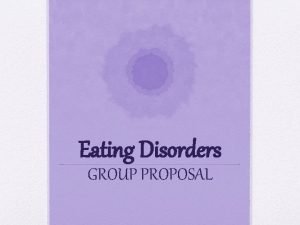Chapter 8 Eating Disorders Eating Disorders An Overview
















- Slides: 16

Chapter 8 Eating Disorders

Eating Disorders: An Overview Two Major Types of DSM-IV Eating Disorders § Anorexia nervosa and bulimia nervosa § Severe disruptions in eating behavior § Extreme fear and apprehension about gaining weight § Have strong sociocultural origins –Westernized views Other Subtypes of DSM-IV Eating Disorders § Binge-eating disorder § Obesity

Bulimia Nervosa: Overview and Defining Features Binge Eating – Hallmark of Bulimia § Binge – Eating excess amounts of food § Eating is perceived as uncontrollable Compensatory Behaviors § Purging – Self-induced vomiting, diuretics, laxatives § Some exercise excessively, whereas others fast DSM-IV Subtypes of Bulimia § Purging subtype – Most common subtype (e. g. , vomiting, laxatives, enemas) § Nonpurging subtype – About one-third of bulimics (e. g. , excess exercise, fasting)

Bulimia Nervosa: Overview and Defining Features (cont. ) Associated Medical Features § Most are within 10% of normal weight § Purging can result in severe medical problems § Erosion of dental enamel, electrolyte imbalance § Kidney failure, cardiac arrhythmia, seizures, intestinal problems, permanent colon damage Associated Psychological Features § Most are overly concerned with body shape § Fear gaining weight § High comorbidity – Anxiety, mood, and substance abuse

Anorexia Nervosa: Overview and Defining Features Successful Weight Loss – Hallmark of Anorexia § Defined as 15% below expected weight § Intense fear of obesity § Relentless pursuit of thinness § Often begins with dieting DSM-IV Subtypes of Anorexia § Restricting subtype – Limit caloric intake via diet and fasting § Binge-eating-purging subtype – About 50% of anorexics Associated Features § Marked disturbance in body image § High comorbidity with other psychological disorders § Weight loss methods have life threatening consequences

Bulimia and Anorexia: Facts and Statistics Bulimia § Majority are female § Onset around 16 to 19 years of age § Lifetime prevalence is about 1. 1% for females, 0. 1% for males § 6 -8% of college women suffer from bulimia § Tends to be chronic if left untreated Anorexia § Majority are female and white § From middle-to-upper middle class families § Usually develops around age 13 or early adolescence § More chronic and resistant to treatment than bulimia Bulimia and Anorexia Are Found in Westernized Cultures

Causes of Bulimia and Anorexia: Toward an Integrative Model Media and Cultural Considerations § Being thin = Success, happiness. . really? § Cultural imperative for thinness translates into dieting § Standards of ideal body size change as much as fashion § Media standards of the ideal are difficult to achieve Biological Considerations § Eating disorders – Can lead to neurobiological abnormalities

Causes of Bulimia and Anorexia: Toward an Integrative Model (cont’d. ) Psychological and Behavioral Considerations § Low sense of personal control and self-confidence § Perfectionistic attitudes § Distorted body image § Preoccupation with food and appearance § Mood intolerance An Integrative Model of Eating Disorders


Medical and Psychological Treatment of Bulimia Nervosa Medical Treatment § Antidepressants – Help reduce binging and purging § Antidepressants are not efficacious in the longterm Psychological Treatment § Cognitive-behavior therapy (CBT) – Treatment of choice § Interpersonal psychotherapy – Gains similar to CBT

Medical and Psychological Treatment of Anorexia Nervosa Medical Treatment § None exist with demonstrated efficacy Psychological Treatment § Weight restoration – First and easiest goal to meet § Psychoeducation – Food, weight, nutrition, health § Behavioral and cognitive interventions § Treatment often involves the family § Long-term prognosis – Poorer than bulimia

Binge-Eating Disorder: Overview and Defining Features Binge-Eating Disorder – Appendix of DSM-IV-TR § Experimental diagnostic category § Engage in food binges without compensatory behaviors Associated Features § Many are obese § Often older than bulimics and anorexics § More psychopathology vs. non-binging obese people § Concerned about shape and weight

Medical and Psychological Treatment of Binge-eating Disorder Medical Treatment § Sibutramine (Meridia) Psychological Treatment § CBT for bulimia appears efficacious. § Interpersonal psychotherapy has been as effective as CBT. § There is some evidence to suggest self-help techniques are also effective.

Obesity: Overview and Statistics Not a formal DSM disorder Concern arises because of related medical complications social and occupational impairments Statistics § In 2000, 20% of adults in the United States were obese § Mortality rates are close to those associated with smoking § Increasing more rapidly for teens and young children § Obesity is growing rapidly in developing nations

Obesity and Disordered Eating Patterns Obesity and Night Eating Syndrome § Occurs in 7 -15% of treatment seekers § Occurs in 27% of individuals seeking bariatric surgery § Patients are wide awake and do not binge eat Causes § Obesity is related to technological advancement § Genetics account for about 30% of the cause § Biological and psychosocial factors contribute as well

Obesity Treatment § Moderate success with adults § Greater success with children and adolescents Treatment Progression § From least to most intrusive options § First step – Self-directed weight loss programs § Second step – Commercial self-help programs § Third step – Behavior modification programs § Last step – Bariatric surgery
 Chapter 18 eating and feeding disorders
Chapter 18 eating and feeding disorders An eating disorder in which people overeat compulsively
An eating disorder in which people overeat compulsively York eating disorders service
York eating disorders service Eating disorders in uae
Eating disorders in uae Acupuncture for eating disorders
Acupuncture for eating disorders Brainpop eating disorders
Brainpop eating disorders Marsipan criteria
Marsipan criteria Psychodynamic explanation of anorexia
Psychodynamic explanation of anorexia How to be anorexic
How to be anorexic Hypothalamus and eating disorders
Hypothalamus and eating disorders How to spot eating disorders
How to spot eating disorders Kate moss anorexia
Kate moss anorexia A 23 year old male experienced severe head trauma
A 23 year old male experienced severe head trauma Emt chapter 14 medical overview
Emt chapter 14 medical overview Chapter 9 lesson 2 photosynthesis an overview
Chapter 9 lesson 2 photosynthesis an overview Chapter 12 selling overview
Chapter 12 selling overview Chapter 2 an overview of the financial system
Chapter 2 an overview of the financial system



